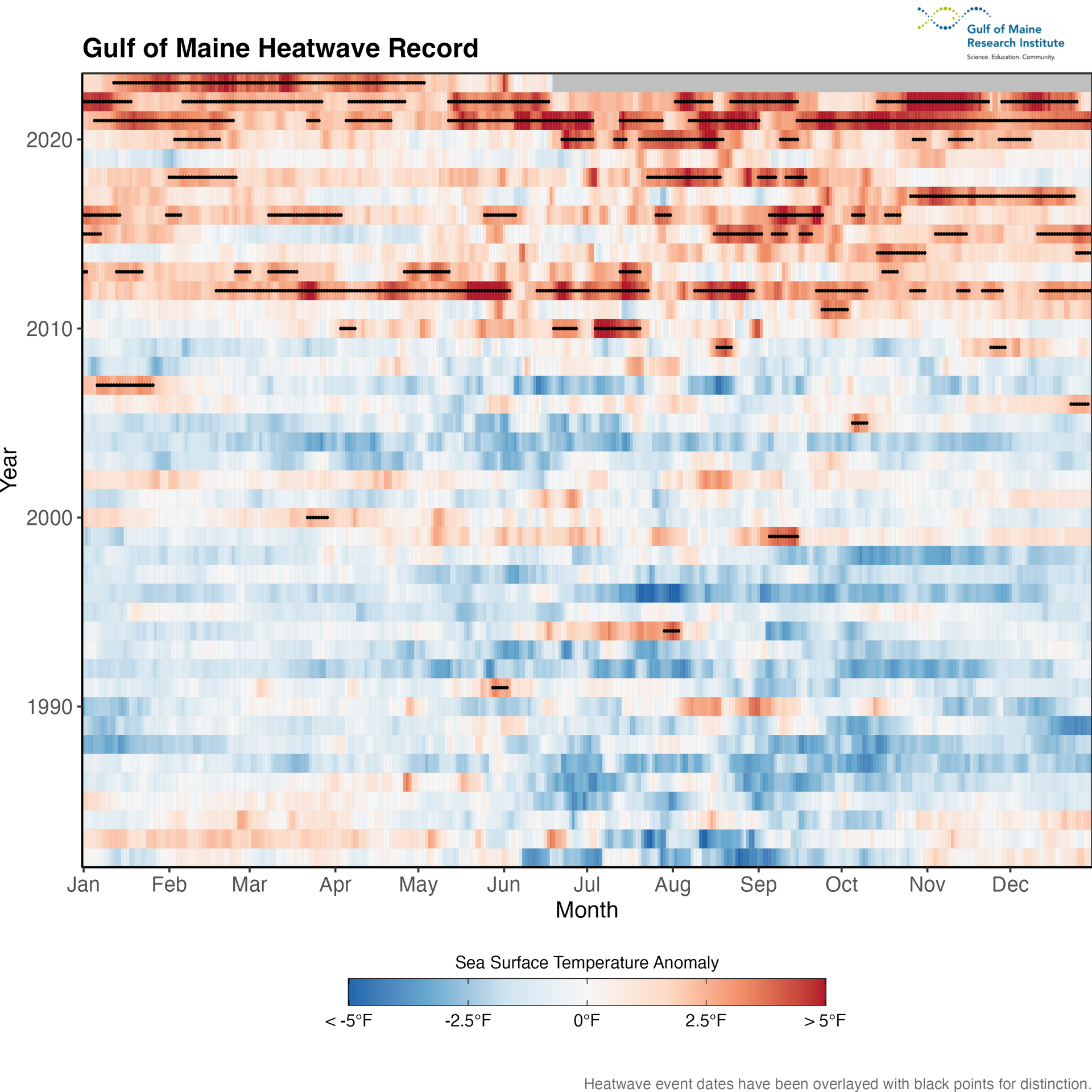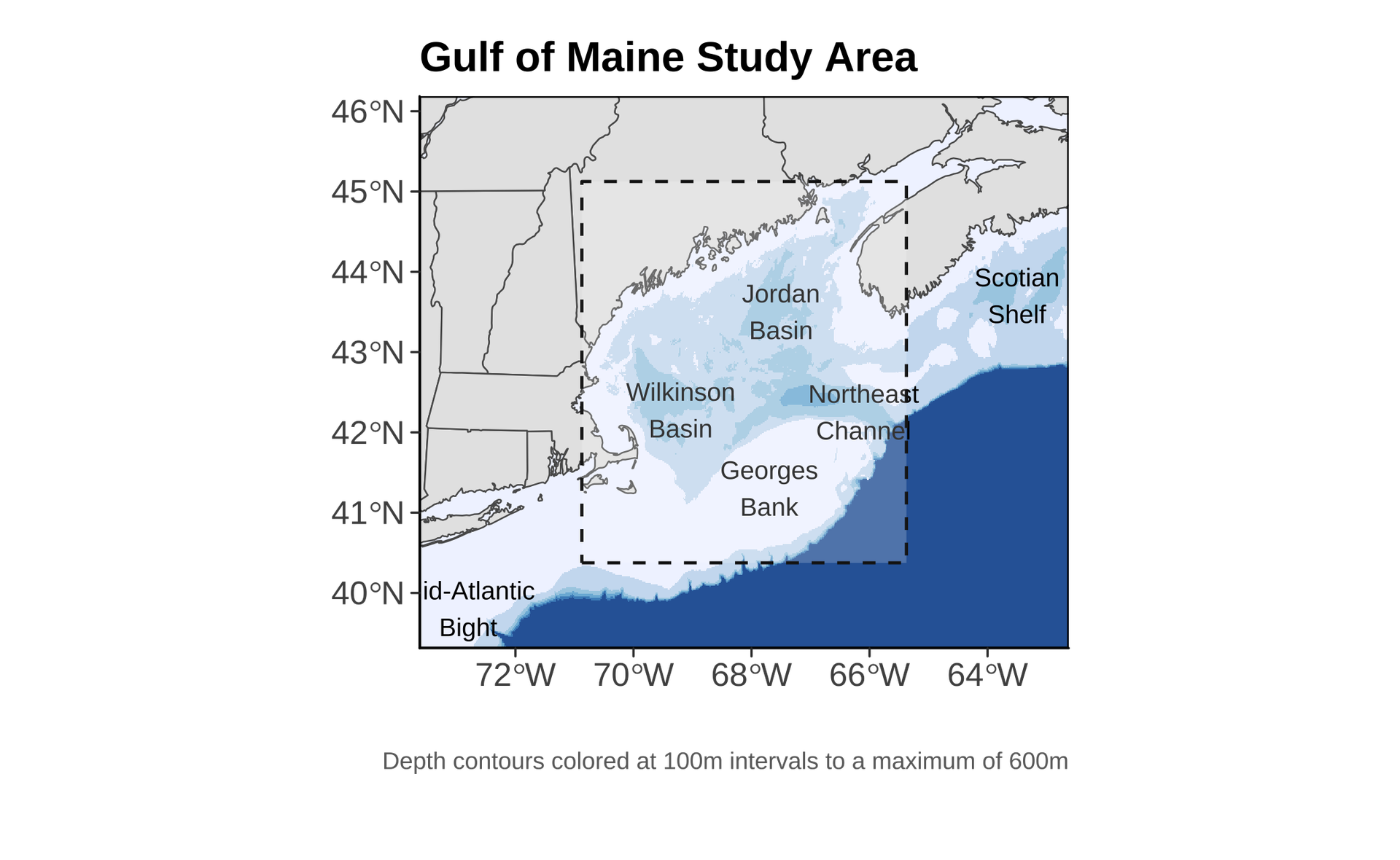Gulf of Maine Warming Update: Spring 2023
Announcements | Jul 5, 2023
Over the past decade, scientists have led a body of research that highlights the rapid pace of warming in the Gulf of Maine. To help keep you informed, we share seasonal and annual updates about conditions in the Gulf of Maine.
Read on for an inside look at what we've learned in our spring 2023 Gulf of Maine warming update.

Highlights
For this seasonal report we present an analysis of SST for spring (March 1st, 2023 — May 31st, 2023). During this season, the average SST for the Gulf of Maine was 45.72°F, making it the second hottest spring on record for the period of 1982–2023 — the years over which the satellite data used are available. This seasonal average temperature is 2.88°F above the 1991–2020 climatological reference period (CRP) spring average of 42.84°F. Record high average monthly SSTs were set in both March and April. Relatively cool SSTs during May (sixth warmest) prevented this year from surpassing 2012 as the warmest spring.
Weekly Sea Surface Temperatures (SST)
In Table 1, we highlight how the average SST for each week this spring compares to those during the same weeks of the 30-year CRP for the area shown in the figure at the bottom of this update.
The table shows the observed SST, long-term average SST, and SST anomalies (i.e., departures from the long-term 1991–2020 average SST). SST anomalies were 2.5°F or more above normal throughout March and April, punctuated by one week in mid-March where SSTs were 4.5°F above the CRP. May saw lower departures from the long-term average SST, with almost every week experiencing anomalies less than 2°F. Notably, though, these SSTs were still well above the long-term average.

Monthly SST Statistics
Table 2 shows monthly average SST for spring 2023, where we see record setting warmth in both March and April (SST anomalies of ~3.5°F above the CRP), before more modest warmth sets in for May (monthly average SST anomaly of 1.64°F, making it the sixth warmest May on record). This continues the trend of record warmth from the winter 2022-23 season, where both December and February set all-time SST records.

Seasonal SST Trends and Anomalies in Context
The Gulf of Maine is an area of particular interest to the scientific community because of the remarkable rate of warming it has experienced over the past few decades, coupled with its importance as a major driver for the regional economy.
When looking at average spring SSTs from the beginning of the satellite record in 1982 (Figure 1), there is a clear long-term increase, with SSTs warming at a rate of 0.57°F per decade. This rate of seasonal warming for spring is ~2.5x the rate at which global ocean temperatures are warming (0.23°F per decade).

The unprecedented levels of warmth over the past decade or so are consistent with what researchers believe has been a distinct regime shift in the major influences on SSTs in the Gulf of Maine. The drivers of this (e.g., a potential weakening of the Atlantic Meridional Overturning Circulation, widening of the Gulf Stream, changes in characteristics of the Labrador Current) have been well-documented in the peer-reviewed literature, including through research by GMRI scientists.
How Does this Spring Compare?
Spring 2023 is now the second warmest spring season observed in the Gulf of Maine during the 41 years we have satellite data to analyze. The top five warmest spring seasons have all occurred since 2012, as illustrated in Figure 2.

Marine Heatwave Conditions
The most commonly used definition of a “marine heatwave” (MHW) is when daily average SSTs exceed the 90th percentile of a climatological (i.e., 30-year) average for at least five consecutive days. Gaps of two days or less in this threshold do not constitute a break in the MHW event.
Applying this broadly accepted definition to the 1991–2020 CRP, the Gulf of Maine experienced MHW conditions for 71% of the 2023 spring season (Figure 3). May was the only spring month in which daily SSTs fell below the threshold of a MHW.

Presenting SST conditions in terms of anomalies (Figure 4) as opposed to absolute values (Figure 3) illustrates in greater detail the magnitude of MHW conditions throughout the spring. The most extreme daily SST anomalies occurred in late March, with temperatures exceeding 5°F above the climatological average.

Temperature Anomalies and Heatwave Events
Looking at the full record of daily SST anomalies in the Gulf of Maine (Figure 5), the distinct thermal regime shift beginning around 2010 is evident. Indeed, since 2012, the Gulf of Maine has experienced far more persistent MHW conditions (indicated by solid black lines) than at any other point in the satellite record.

While it is clear in Figure 5 that MHWs have become more regular and intense in the past decade, some viewers may note that there are fewer MHWs marked in this figure than in our previous SST updates. This difference reflects the change in the CRP used in our SST analyses as described in the beginning of the winter 2022–23 update. Many of the time periods where SSTs had been above the 90th percentile for the 1982–2011 CRP are no longer above that 90th percentile threshold for the 1991–2020 CRP, since this more recent 30-year period has experienced warmer average conditions in the Gulf of Maine.
Spatial Distribution of Seasonal SST Anomalies
From a spatial perspective, most of the Gulf of Maine and surrounding areas experienced above average SSTs during spring 2023, but the warmest patches were to the south of Georges Bank, mostly outside the domain analyzed in preceding sections (Figure 6). The highest seasonally averaged SST anomaly of any location above was 6.11°F — occurring just south of the area represented in the analyses shown in Figures 1 through 5 above.

Monthly Spatial SST Anomalies
Monthly average SST anomalies across the region of study are shown in Figure 7. The warmest anomalies were observed in March and April when a large area to the south-southeast of Georges Bank experienced SST anomalies in excess of 8°F, well above the climatological average. This deepwater area just off the continental shelf is where the impacts from the evolving nature of the Gulf Stream can be seen most clearly. The changing behavior of the Gulf Stream has caused warmer and saltier Gulf Stream waters to push up against the shelf slope near Georges Bank before it enters the Gulf of Maine. This warmer Gulf Stream water crosses over the shallower habitat of Georges Bank and at depth through the Northeast Channel located in the east-southeast portion of the Gulf of Maine. This May, SSTs had swung strongly in the opposite direction, with much weaker warm anomalies in the Gulf of Maine and strong cool anomalies off the continental shelf. The intra-seasonal temperature swing exceeded 16°F in some areas, highlighting the dynamic and volatile nature of this region in the Northwest Atlantic Ocean where major ocean currents (i.e., Gulf Stream and Labrador Current) interact.

A Note on Data Sources:
NOAA_ERSST_V5 data provided by the NOAA/OAR/ESRL PSL, Boulder, Colorado, USA.
NOAA High Resolution SST data provided by the NOAA/OAR/ESRL PSL, Boulder, Colorado, USA.
The Gulf of Maine Region
For analyses like these, it is important to be clear about the spatial extent that “defines” the Gulf of Maine (figure below), as different borders could produce different results. The spatial domain we use as the “Gulf of Maine” is displayed below. This area is consistent with previous reports and publications GMRI has produced.




